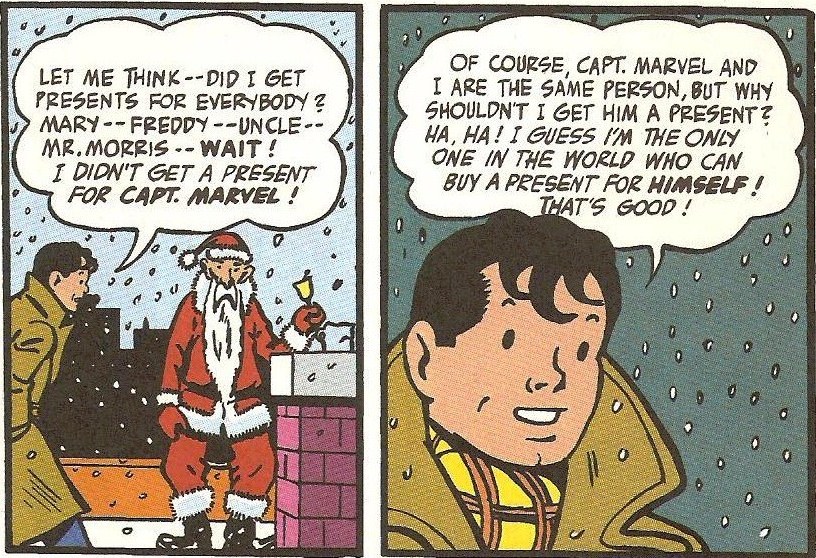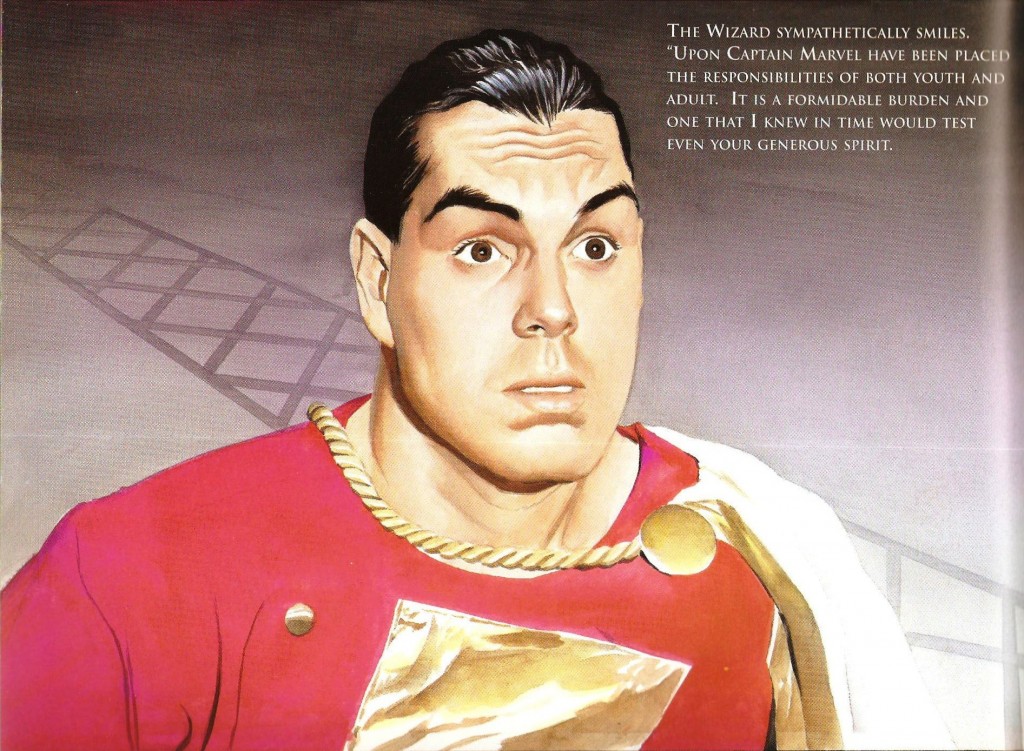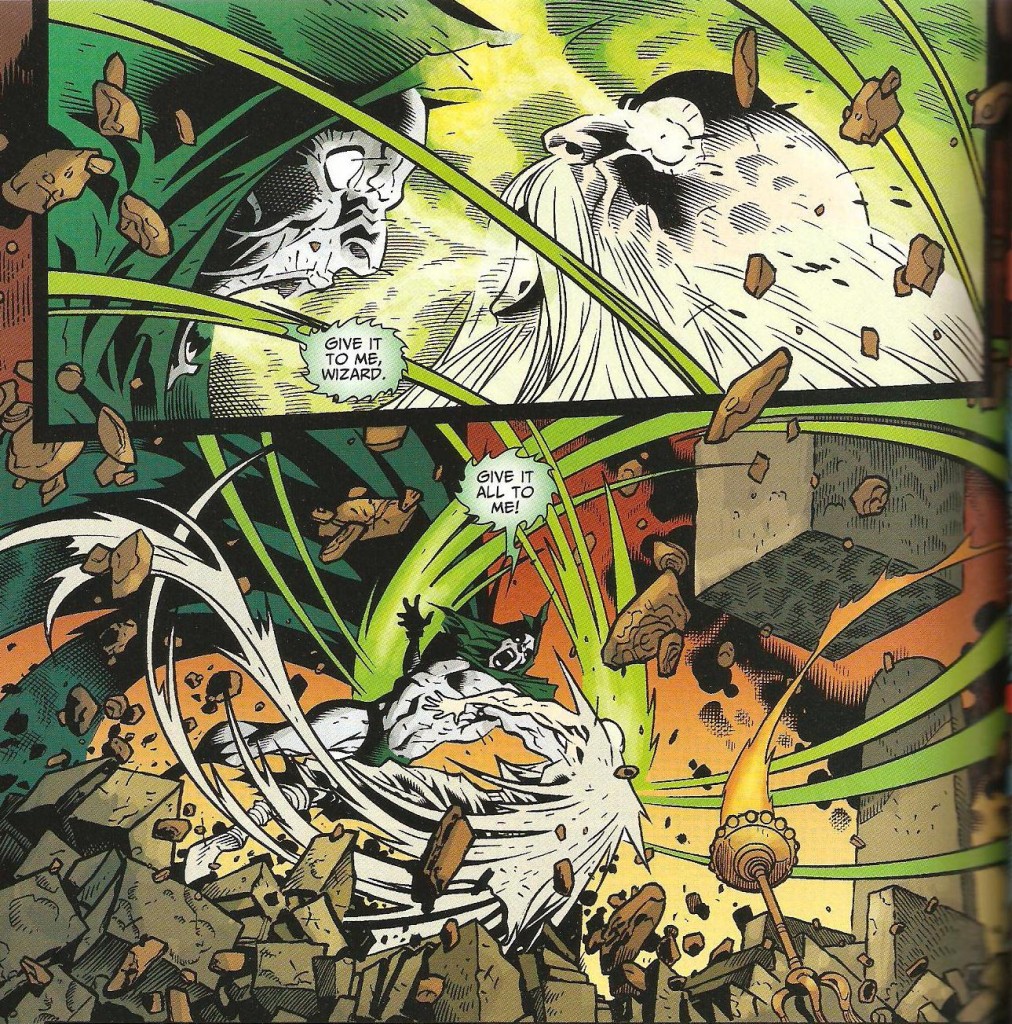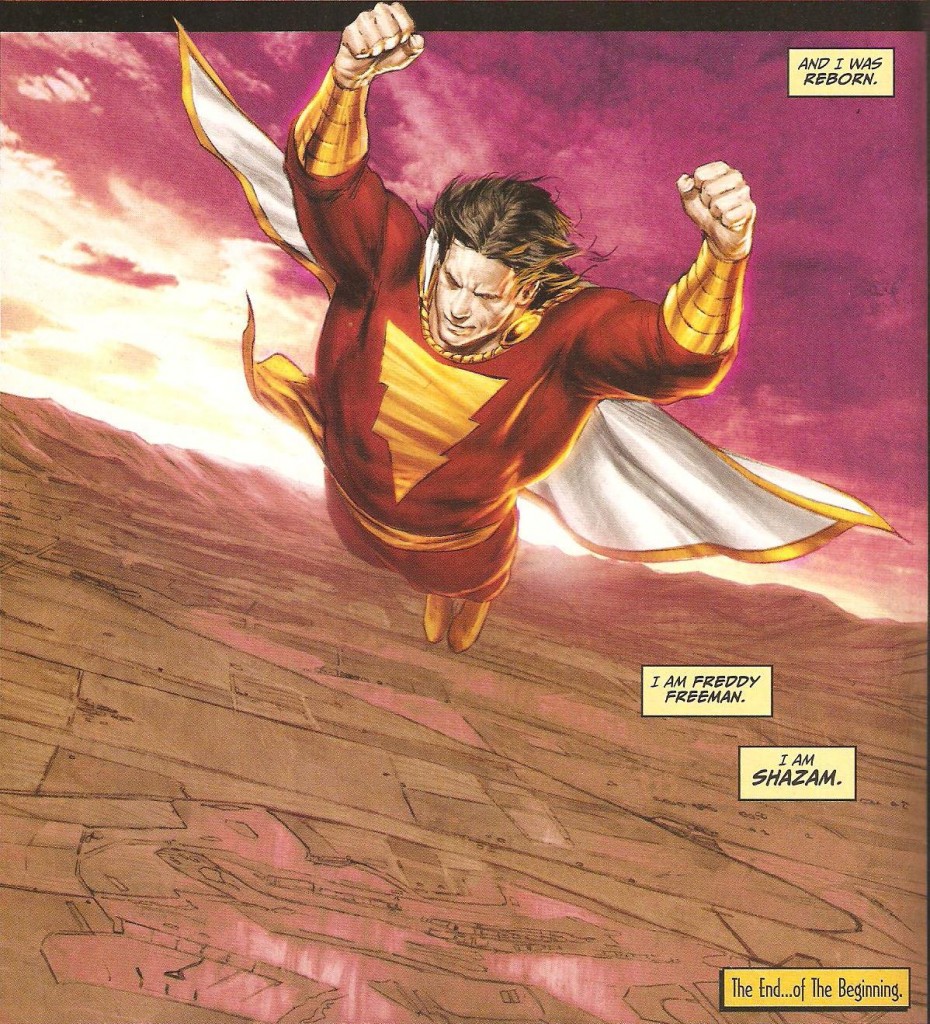Welcome back to another DC History. We’re well into the New 52 at this point, but there’s still much that can be gained by examining how we got here. Only by looking back at what came before can we understand where we’re going.
This week, we’re looking at Captain Marvel, better known to most of the world as Shazam. He’s getting another update in the pages of Justice League #7. Let’s spend some time examining his previous incarnations, shall we?
Created by C.C. Beck and Bill Parker, Captain Marvel first appeared in the pages of Whiz Comics just two years after Superman debuted. Instead of being rocketed to Earth from another planet, Captain Marvel was, in reality a small boy named Billy Batson. A wizard named Shazam thought that the poor boy had an honest soul, so he endowed Billy with the abilities of six gods in order to help fight for justice. Captain Marvel boasted the wisdom of Solomon, the strength of Hercules, the stamina of Atlas, the power of Zeus, the courage of Archilles, and the speed of Mercury. He was the world’s mightiest mortal. Whenever Billy shouted Shazam, he was transformed into Captain Marvel.
Nearly from day one, Captain Marvel was a hit. Published by Fawcett Comics, the adventures of Captain Marvel rivaled and even surpassed the sales of his contemporaries like Superman and Batman. It’s fairly easy to understand why. Captain Marvel was both hero and kid. Young readers could easily latch on to the empowerment fantasy of the story and project themselves into the story. It was wish fulfillment and readers read it in droves.
Just a year after Captain Marvel debuted, he was given his own movie serial. Spread out over 12 weeks, The Adventures of Captain Marvel was the very first comic book superhero adaptation on the silver screen. Its special effects still look pretty darn good today and while I haven’t seen every single 1940s serial, this is easily my personal favorite.
The relationship between Billy and Captain Marvel is one that many creators played with over the years. Were they two different people? Was Billy’s mind completely in control of the Captain or was he an autonomous being? Early on, the relationship between the two was left pretty ambiguous. Since the 1970s, it’s nearly always shown that Billy is in complete control of Captain Marvel, who doesn’t have a separate personality.
National Publications, the publishing company that would one day go on to become DC Comics, was upset with Captain Marvel’s popularity. At his height, Captain Marvel sold 14 million comics in 1944. Feeling that Marvel was a direct copy of Superman, National sued Fawcett in court in an attempt to block Captain Marvel’s adventures from being published. In 1952, they succeeded. Captain Marvel was legally deemed a copy of Superman. Fawcett settled with National and, in 1953, Captain Marvel was cancelled. For more details about this whole matter, seek out Fred Van Lente and Ryan Dunlavey’s excellent Comic Book History of Comics.
Fawcett’s Captain Marvel and his family of characters were off comic racks for years. In 1973, DC licensed the rights to the old Fawcett characters and launched a new ongoing series featuring the Marvel Family. It wasn’t until the early 1990s that DC purchased the characters outright. Apparently, a clone of Superman was fine with them as long as DC was the publisher. Billy Batson and his sidekicks Captain Marvel Jr and Mary Marvel were back in the pages of Shazam.
Here’s where the confusion about Captain Marvel’s name begins. During the long hiatus forced upon Captain Marvel, Marvel Comics decided that the name Captain Marvel was a good one. Since no one was currently using the name, and since it hadn’t been used since 1953, they launched their own Captain Marvel character in 1968. He had his name in the title of his own book and was completely unrelated to the Fawcett character. By the time DC got around to relaunching the good Captain, they no longer had the trademark to his name. They decided to name their new series after the magic word that changed Billy into Marvel. ‘Shazam’ would be in the title of every subsequent Captain Marvel series.
In any case, DC relaunched Captain Marvel into his own separate pocket of the DCU. He, along with his supporting cast, lived on Earth-S. Superman and the rest of the DCU lived on Earth-1. The two worlds didn’t cross over. However, as a kind of test run to see how Superman fans would react to a meeting between their hero and Captain Marvel, DC lined up a Captain Marvel surrogate to square off against Superman. In 1974, Superman went up against Captain Thunder.
Fans reacted well to the story and clamored for a real meeting between the former legal opponents. DC acquiesced and two years later, the heroes came inches from going toe-to-toe when Earth-1 and Earth-S finally met. Just moments before a massive slugfest commenced, Captain Marvel turned back into Billy Batson and robbed fans of the fight they were demanding.
The promise of that battle teased in Justice League of America was fulfilled in future stories. Most memorably to me, a young Superman fanatic in 1992, was the battle between Captain Marvel and an Eclipso-possessed Superman. Captain Marvel was the only character who could slug it out with the Man of Steel until a solution to Superman’s condition could be reached. Sadly, the fight ended in a draw.
Captain Marvel was totally integrated into the DCU in the aftermath of the Crisis of Infinite Earths. After that series, all of the various Earths were combined into a single continuity although the Captain would have to wait until the Legends event to make his first appearance alongside his fellow heroes. When that story wrapped up, DC launched a four-issue miniseries which presented Billy’s transformation into Captain Marvel but with a modern twist. This time, Billy was presented as the nephew of Doctor Sivana, one of Captain Marvel’s oldest villains.
After running away from his uncle’s home, Billy stumbled across the wizard Shazam who gave Billy his powers. In this series, as in most subsequent Captain Marvel revivals, Billy Batson was in complete control of the Captain Marvel body. The two were one and the same person. While that series was being published Captain Marvel joined the latest incarnation of the Justice League though he quickly left after everyone agreed he was a poor fit.
He next showed up in Action Comics Weekly, an anthology series that launched as a way to give Action Comics a new identity. This new format lasted less than a year. In this series, Captain Marvel was given a four issue long story. At the story’s conclusion, a teaser was published letting readers know that an ongoing Shazam series would begin soon. The announcement was premature as that series never launched.
After his solo series fell through, Captain Marvel wasn’t really a character. He was a caricature who would be very naive to the ways of the world. This was mostly played for comedy and since he was only a guest star in other people’s comics, he was never fleshed out.
Eventually, Jerry Ordway took a crack at reexamining Captain Marvel in a stand-alone graphic novel published in 1994. Titled The Power of Shazam!, this story once again retold Billy’s first meeting with Shazam and the first appearance of Captain Marvel. Here, Doctor Sivana wasn’t Billy guardian. Billy lived by himself and occasionally used Captain Marvel’s body to let him masquerade as his own uncle.
The story was so well received that The Power of Shazam! launched as an ongoing series the next year. It lasted four years, which isn’t an awful run. In the pages of this series, most of the Marvel Family, including Marvel Family stewards Captain Marvel Jr. and Mary Marvel, were introduced into the standard DCU. Quite honestly, I haven’t read enough of this series but would really like to. It certainly seems like something I would enjoy.
For many creators who worked on Captain Marvel stories, the idea of why the wizard Shazam chose a young boy to gain the powers of the gods was an important one. Several writers and artists tackled this question. For instance, the Captain appeared in a gorgeous book written by Paul Dini and painted by Alex Ross. Presented in an oversized tabloid format, Shazam! Power of Hope told a story about a time when Billy was as much in need of hope as the people he chose to help. It was also about how children can inspire hope in others, an ability in Captain Marvel that many other heroes lack.
Over in the pages of JSA, a modern day relaunch of the Justice Society of America, Geoff Johns ushered Captain Marvel into the group. Alongside other golden age heroes like the original Flash and Green Lantern, the Captain seemed to fit right in. However, because Captain Marvel was really a teenager, he began to have feelings for his sixteen year-old colleague Stargirl. She knew the truth about the Captain’s age but shared this knowledge with none of her teammates. After the Flash saw how the pair looked at each other, he confronted Captain Marvel about their relationship. Instead of explaining the situation, Billy left the group.
Billy’s fears were well founded. In a story that retold the first meeting of Superman and Captain Marvel, Superman learned the truth about Billy. Enraged that the wizard chose such a young boy to fight the terrible menaces of the world, Superman confronted Shazam and attempted to lay a big pile of righteous indignation at Shazam’s feet. The wizard would have none of it.
Captain Marvel’s status quo got a massive shake-up just prior to Infinite Crisis. In the lead up to that Crisis, the Spectre was removed from his human host. Without a piece of humanity to ground him, the Spectre began to go wild. Anything that had a magic base was deemed unnatural and the Spectre began systematically wiping it out of existence. Shazam, in a desperate attempt to stop the Spectre, fought the spirit. Sadly, the wizard died in the battle.
Shazam was a cornerstone of the mystic DCU. With his death, the nature of magic shifted. Spells stopped working and everyone who counted on Shazam to power them were left impotent. It really left Captain Marvel Jr. in a lurch.
In order to set matters right, Billy Batson took over the role made vacant by the wizard’s death. Calling himself simply Marvel, Billy called upon Freddy Freeman, the former Captain Marvel Jr., to undergo a series of trials in order to once take up his friend’s former mantle.
Freddy overcame all of the challenges laid before him. He gained the personal confidence of all six gods who had given Captain Marvel his powers. Finding the name available, Freddy simply called himself Shazam.
It really doesn’t make too much sense for Freddy to take that name, but from a branding perspective it makes total sense. Why not name your character whatever is on the cover of the book? That’s what many people thought his name was anyway.
This new status quo didn’t stick around too much longer after this. Billy Batson actually lost his role as Marvel after a confrontation with Black Adam, his old nemesis and frequent sparing partner. That left Freddy as the only welder of the gods’ power in the DCU. That’s where everything was left before the New 52 began.
What is Shazam’s new status quo in the New 52? We’ll have to find that out together. All we know is that Billy is once again the person behind the thunderbolt and that he goes by Shazam now. Here’s hoping he’s every bit the hero he’s been since 1940.
Jeff Reid knows that he didn’t talk about Kingdom Come. It’s a good Captain Marvel story but it’s outside of the regular DCU. Also, this article is already really, really long. It’d never fit on Twitter.


















I just started reading Power Of SHAZAM recently, and am enjoying it for the most part. It’s kinda weird sometimes, though, since Ordway tries to both modernize the franchise and keep it old timey & corny at the same time. It creates a weird rift when reading at points.
I’ve heard that was a problem with Ordway’s series. Marvel himself isn’t necessary corny but it’s his supporting cast that can make him seem that way. Still, I’ll try to keep my eyes open for it.
Perhaps corny was a wrong choice of words…it’s like if someone made one of those old timey serials (using the exact type of dialog and melodrama) and put it in a contemporary setting.
the stargirl/shazam situation sounds like great storytelling. never really got into jsa, so i missed out on that storyline.
i’ve always loved the idea of shazam’s character, but haven’t read that many great comics starring him.
i hope this is change i can believe in.
No mention of Jeff Smith?
Love that YouTube clip. The actor playing Captain Mavrel is so grim. But the flying effects are remarkably good!
This article was already on the brink of being too bogged down in trying to explain the various incarnations of Captain Marvel that I was worried mentioning the Jeff Smith series and the Billy Batson and the Magic of Shazam series that followed it would lose readers unfamiliar with the material. But yes, the Jeff Smith series in particular is really great. It’s one of the few places where it’s decided that Captain Marvel and Billy Batson are two separate people.
Supposedly, the flying affects in the Captain Marvel serial were created by a paper mache man on a string. It’s practical and holds up over 70 years later. Over in the Superman serials, they just animated a flying Superman for their flight scenes. It was a poor choice.
LOVE The Monster Society of Evil. It is one of the very few Captain Marvel stories I’ve read. Can’t wait to see him in the Justice League backup; and I believe it’s Gary Frank drawing him, that makes me even more excited.
I always thought the idea of them being two seperate people was kinda weird. Think about; Captain Marvel has a little kid inside him. Am I right?
Also, I wish they’d kept the name Captain Thunder. It’s an awesome name.
I just remembered that the Flashpoint version of Captain Marvel was called Captain Thunder. The name is still floating around out there.
my head started spinning…
I thought Trials of Shazam was an awesome read. I liked his character in JSA as well. Think I should chase down some of these others like Power of Shazam and First Thunder.
Shazam has been one of the best supporting characters on Young Justice
Thanks, Jeff.
I think I’ll read some of these this summer.
I got into the character briefly around 1973, but even then there was a weirdly dated feel to the character.
It seems to work best when either played with a bit of humor, or with an understanding of what makes being ten or twelve such a strange yet magical age.
Nice article.
Marvel’s Captain Marvel has a lot more in common with the original than just a name: he was bonded with the teenaged Rick Jones in such a way that they shared molecules, with one disappearing into a side-dimension when the other was in the physical world mirroring the Billy Batson/Cap. Marvel relationship.
Nice article, Jeff. I recently re-read the entire run of Power of Shazam! and can recommend it without question. One series that wasn’t mentioned in the article is the run from World’s Finest, from the late 1970s through to the early 1980s. A beautiful series which really needs to be collected.
Just read the new Shazam! series in Justice League and so far so good. Hopefully this will lead into a new monthly within the next year.
I remember the super white bread Captain Marvel in the Bwah-Ha-Ha Justice League books. He didn’t stick around long, but he was entertaining, if not consistent with how I think the Big Red Cheese should be portrayed.
They can call him Shazam all they want (and I shudder to hear it) but to me he will always be Captain Marvel.
It’s always sad to see a creator owned character put on hold for so many years..look at how many Supermen are running around out there now.
Captain Marvel was/is kinda similar to Superman but I like both characters and see them as completely different…I can see the similarity of both characters being an issue back in their early years tho.
Still sad to see what happened to CM for so many years.
Sort of left Mary Marvel out of things didn’t you?
She’s probably in there as much as she should be considering it’s not a profile about her.